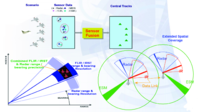
Photo from wikipedia
We focus on the problem of finding optimal sensor locations for source localization techniques based on either time of arrival (TOA) or received signal strength (RSS) measurements. Without any specific… Click to show full abstract
We focus on the problem of finding optimal sensor locations for source localization techniques based on either time of arrival (TOA) or received signal strength (RSS) measurements. Without any specific assumption on the actual source position, we propose a design framework that directly establishes the optimal sensor locations by minimizing suitable Cramer-Rao bound (CRB)-related cost functions. Specifically, we just consider a region where the source is likely to be present and focus on two cost functions: the former relies on the trace/determinant of CRB averaged over a grid of points resulting from the sampling of the surveillance area (shortly average CRB), whereas, the latter leverages the maximum trace/determinant of CRB over the mentioned grid (shortly worst-case CRB). Moreover, each sensor position is constrained to lie within a pre-specified set (deployment constraint set). Hence, we propose an optimization framework based on block majorization-minimization to deal with both the design paradigms. The iterative steps of the technique monotonically decrease the corresponding figure of merit and eventually converge to a stationary point of the design problem. The proposed methodology can also handle the case of nonuniform noise variances. Finally, through various numerical simulations, we show the effectiveness of the developed resource allocation policies.
Journal Title: IEEE Transactions on Signal Processing
Year Published: 2023
Link to full text (if available)
Share on Social Media: Sign Up to like & get
recommendations!